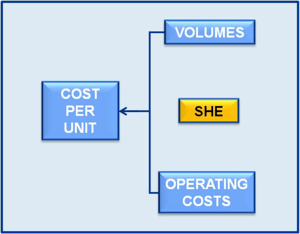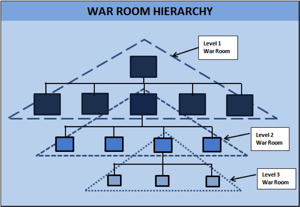One of the most common, and useful measures of operational profitability for many organisations is COST per UNIT.
Unfortunately this concept is discussed at higher management levels, but rarely at lower levels.
Lower down we tend to talk about volumes and operating costs in isolation with little reference to each other. This results in the much debated problem of chasing volumes while ignoring costs. The converse also occurs frequently with equally damaging results.
When people really understand this concept and have the appropriate information, they are able to make more balanced operational decisions with a positive impact on cost per unit.
While I was researching this concept and trying to find the best way to get everyone in an organisation to consciously focus decisions and actions on reducing cost per unit, I came across many systems and techniques such as the “Value Driver Tree,” which is a useful concept, but in the wrong hands it tended to complicate rather than simplify.
I also saw many types of work team systems which displayed performance information, but often the information was too generic to be of any real use. Or the information displayed tracked pockets of performance without a coherent link to the real issue - Cost per Unit. Most often it was seen as a “shop floor” or “frontline” intervention with little involvement of higher organisational levels.
While working with organisations to set up systems to capture and track information related to cost per unit, I found one common issue: Information dissemination systems are not set up to enable people to get the performance data they need to run their units effectively. For example: The way financial data is converted into reports is often designed to suit senior financial managers and the formats demanded by corporate executives. In one of my clients a first line supervisor wanted to get information showing expenditure against budget on certain consumables, I found that the system was simply not set up to accommodate this.
Although I have seen this dilemma in every organisation I have dealt with (yes I mean every organisation), I am still surprised at how people are expected to manage a unit effectively with very poor information. This in my opinion is one of the most debilitating conditions to work under, yet it is so common place. This condition is widespread across all levels, but the fallout is felt most keenly at the lower levels.
The good news is that this situation is relatively easy to rectify. Most modern organisations do have systems in place to capture data (some have spent millions on this), so it is often all there, all that needs to happen is for the right information to be provided in the right format to people at all levels. Yes there are challenges in providing this information; some software driven databases are very inflexible and costly to change. But when companies see the significant benefits derived from providing information, these costs and efforts pale into insignificance.

The displaying of information is not an end in itself, but rather a means to a greater end. That being performance improvement. If information does not enable people to directly impact on cost per unit it is of no use.
Given the right information, people are able to clearly see the specific barriers impacting on their cost per unit performance; allowing them to identify their own improvement initiatives without any prompting from senior management. This same information then allows for the tracking of results from these initiatives. This information effectively allows people to “go to war” against waste and inefficiencies. Hence the term War Room has been used to denote a place where information is displayed and the team meets, and from which improvement initiatives flow.
Once initiatives are identified, we would encourage the use of the KEPNERandFOURIE Problem Solving Processes and tools, which ensure a project approach with thorough analysis of information.
 The displayed information should be set up in such a way that ensures a standardisation of information from the top down. This dramatically improves the ability of senior management to steer the organisation along a certain course, and to change this course as necessary. For example; in certain sections of the business there may be a need to increase throughput. To achieve this, these sections simply need to focus more on throughput related improvement initiatives.
The displayed information should be set up in such a way that ensures a standardisation of information from the top down. This dramatically improves the ability of senior management to steer the organisation along a certain course, and to change this course as necessary. For example; in certain sections of the business there may be a need to increase throughput. To achieve this, these sections simply need to focus more on throughput related improvement initiatives.
So—the key to real improvement in strategy-critical areas is having the right information at every level of the organisation.
For more information on the KEPNERandFOURIE Business Improvement Process contact Nick Bickell.
17 April 2015




